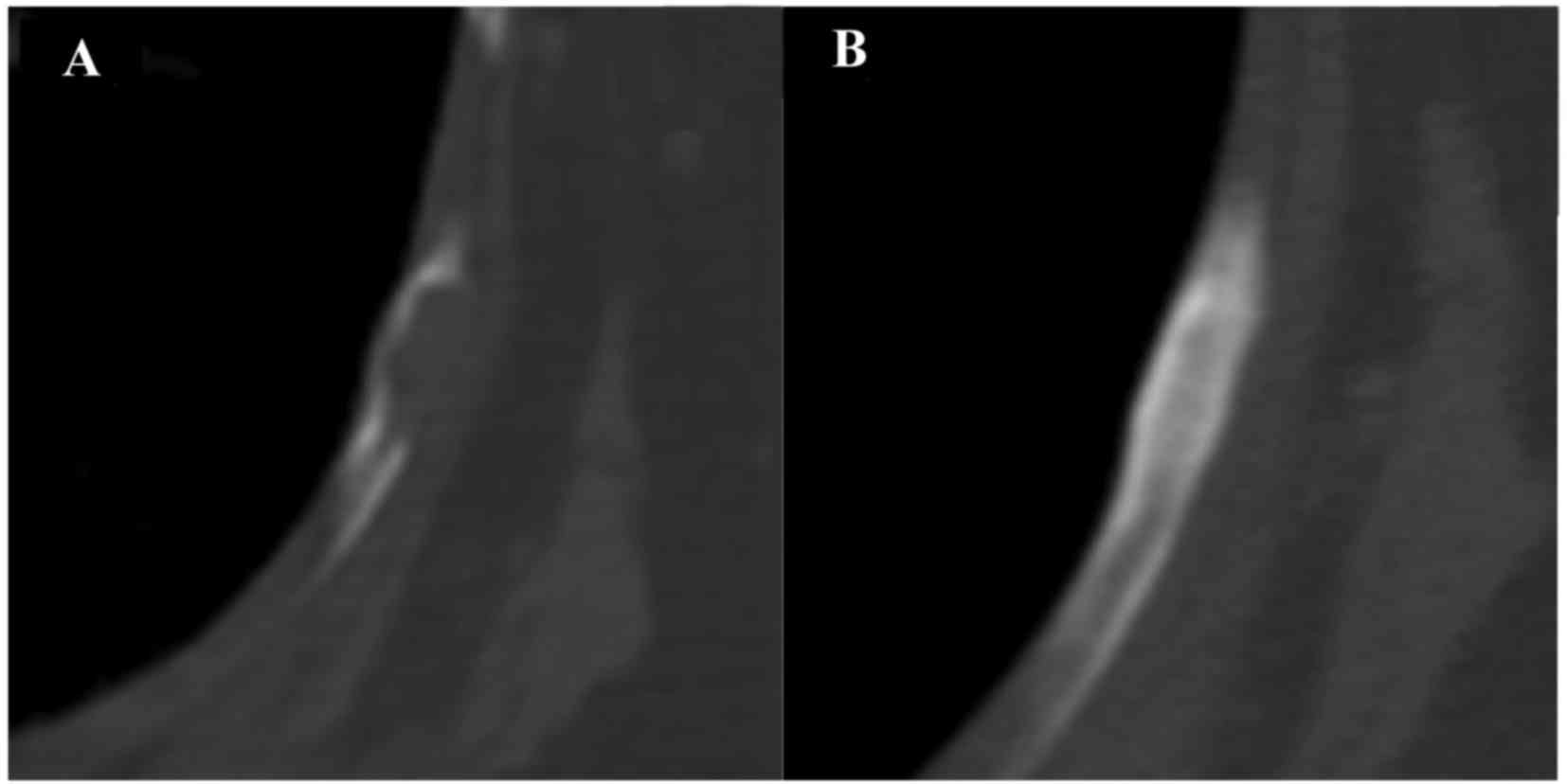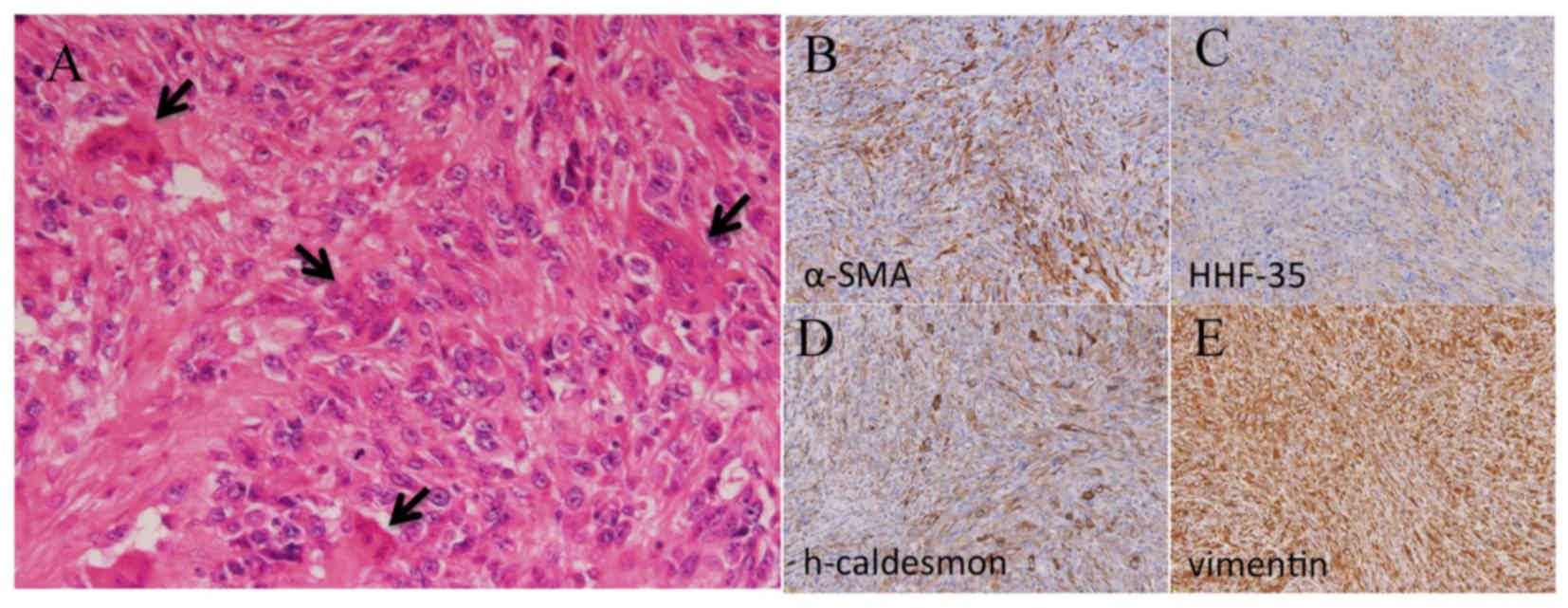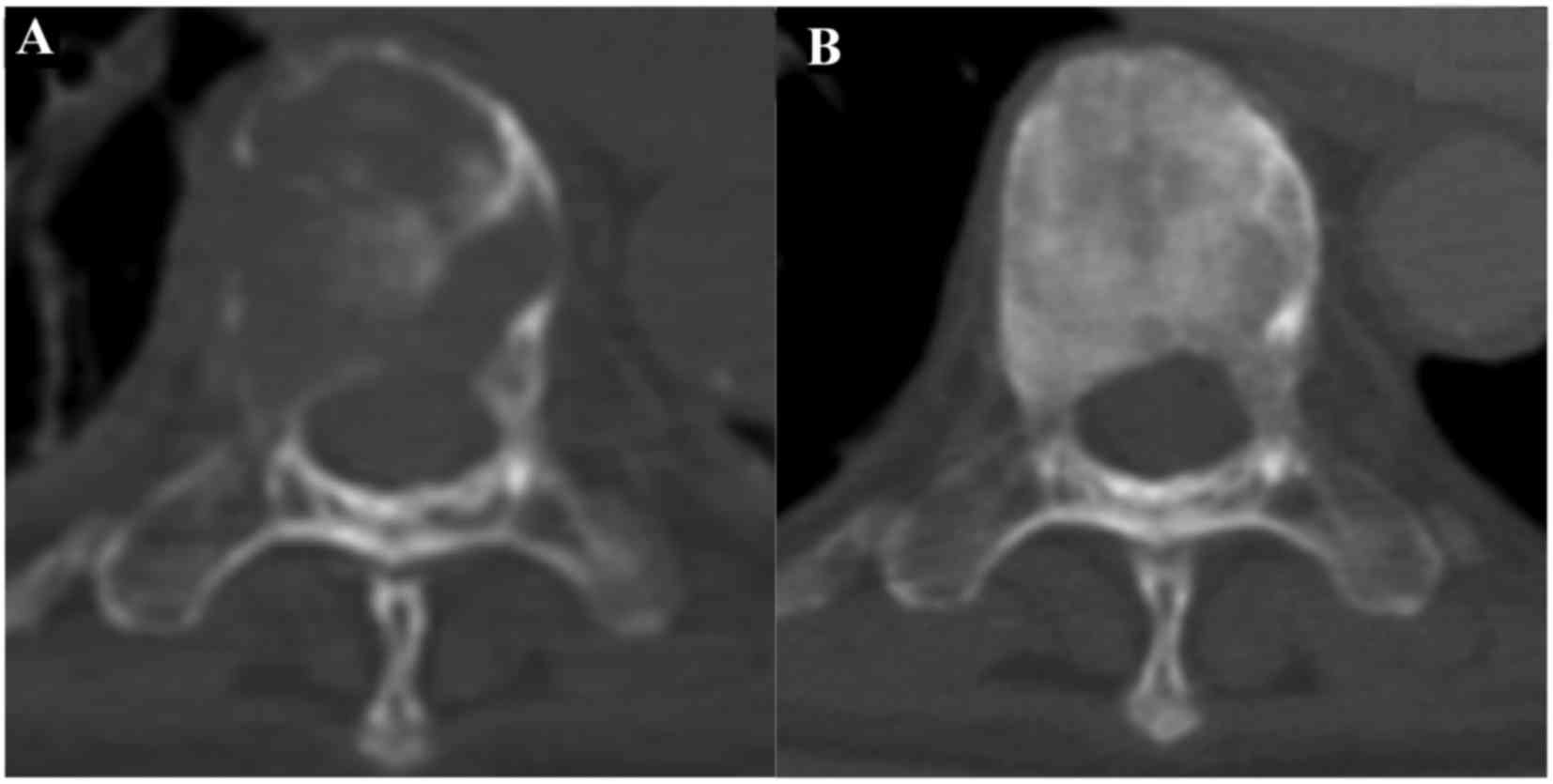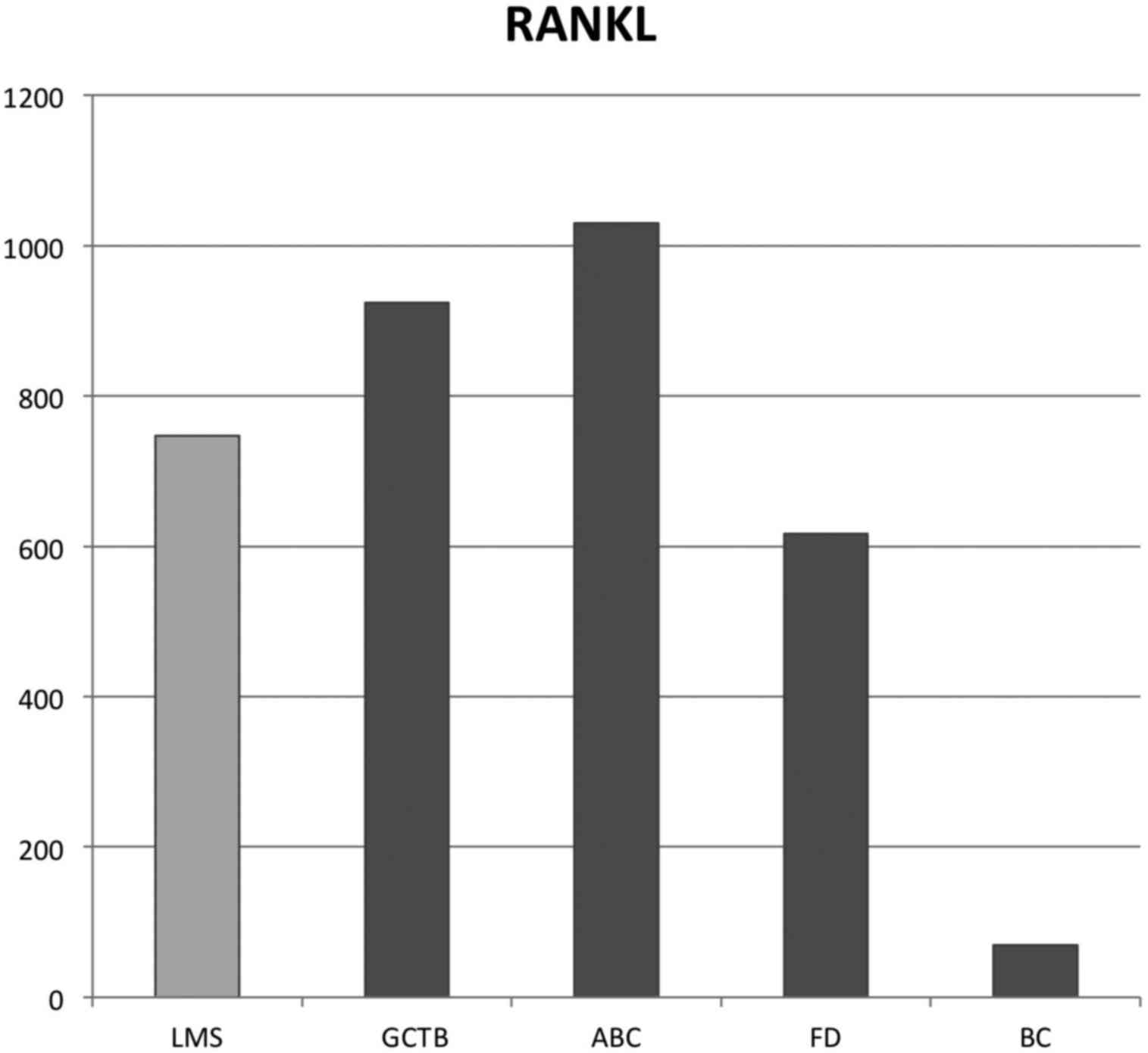Denosumab as a potential therapeutic option for leiomyosarcoma with osteoclast‑like giant cells: A case report
- Authors:
- Published online on: November 6, 2017 https://doi.org/10.3892/mco.2017.1489
- Pages: 30-33
-
Copyright: © Sasaki et al. This is an open access article distributed under the terms of Creative Commons Attribution License.
Abstract
Introduction
Leiomyosarcomas are typically malignant soft tissue tumors composed of spindle cells that exhibit distinct smooth muscle differentiation. Leiomyosarcomas usually occur in the uterus, retroperitoneum, skin, or soft tissues; however, in exceedingly rare cases, they may present as primary bone tumors. Bone leiomyosarcomatous tumors tend to develop at a median age of 47 years (range, 9–87 years) (1), with a minor predominance in men. Patients typically complain of pain and occasionally present with pathological fractures (1). Characteristic plain radiographs show an osteolytic lesion involving the cortical and medullary bone (2).
We herein present the case of a patient with bone leiomyosarcoma displaying osteoclast-like giant cells and report the significant therapeutic effect of denosumab, a receptor-activator of nuclear κB ligand (RANKL) inhibitor that blocks osteoclastogenesis.
Case report
A 64-year-old woman complaining of left shoulder pain with resulting impairment in daily activities underwent radiography and computed tomography. The imaging examinations revealed an expanding lytic lesion of the left clavicle along with multiple osteolytic lesions in other regions, including the skull, right scapula, humeri, ribs, cervical and thoracic vertebra, right ilium and femora. On tumor staging studies, there was no evidence of pulmonary metastasis or other primary tumors. The patient became increasingly bed-confined due to multifocal bone pain. An iliac bone tumor biopsy revealed atypical spindle cell proliferation with active mitosis (>20/10 high-power fields) and partial necrosis. Osteoclast-like giant cells were occasionally observed (Fig. 1). Immunohistochemical analyses revealed expression of α-smooth muscle actin (smooth muscle-specific actin), h-caldesmon and vimentin (Fig. 1). These observations confirmed the diagnosis of bone leiomyosarcoma.
Denosumab (120 mg/day) was administered subcutaneously for 4 weeks, in addition to daily supplementation with calcium and vitamin D. Furthermore, the right scapula, cervical and thoracic vertebrae, left clavicle, femora and right humerus were subjected to standard radiation therapy as palliative care. The patient did not undergo adjuvant chemotherapy or surgery.
After 10 weeks of denosumab administration, the pain symptoms resolved and the patient recovered from the bedridden status. There were no reported denosumab-related side effects. The first follow-up computed tomography examination, performed 2 months post-denosumab treatment, revealed that all tumor growth had stabilized. Osteosclerotic changes were observed in multiple osteolytic lesions following denosumab and radiation combination therapy and denosumab therapy alone (Figs. 2 and 3). However, after 14 months of denosumab administration, a new lumbar vertebral metastasis was detected. At 56 months since denosumab administration, the patient had developed multiple metastases that had led to multiple organ failure, and finally succumbed to gastrointentinal bleeding.
 | Figure 3.Costal lesion (A) prior to treatment and (B) 2 months after treatment with denosumab alone. |
RANKL expression
RANKL gene expression was evaluated in a biopsy of the iliac bone metastasis in the present case, and in surgically resected samples from giant cell tumors of bone (GCTB, n=6), aneurysmal bone cysts (ABC, n=2), fibrous dysplasia (FD, n=6) and bone metastases from breast cancer (BC; n=3).
Total RNA was prepared from iliac bone biopsies using ISOGEN reagent (Nippon Gene; Tokyo, Japan) according to the manufacturer's recommendations. cDNA synthesis was performed using the PrimeScript™ RT reagent kit (TaKaRa Bio; Tokyo, Japan). Quantitative polymerase chain reaction analysis was performed using SYBR Premix Ex Taq II in a Thermal Cycler Dice Real-Time System TP800 (TaKaRa Bio; Otsu, Japan). RANKL was selected as the target gene (forward primer: 5′-GCCTTTCAAGGAGCTGTGCAA−3′, reverse primer: 5′-ATCTAACCATGAGCCATCCACCAT-3′) and GAPDH was selected as the reference gene (forward primer: 5′-GCACCGTCAAGGCTGAGAAC-3′, reverse primer: 5′-TGGTGAAGACGCCAGTGGA-3′). A standard curve was generated using the SaOS2 osteosarcoma cell line, and was used to calculate gene copy numbers. RPMI8226, a myeloma cell line, was used as the calibrator. The target gene expression level was calculated as the ratio of the copy number of the target gene to that of the reference gene. Finally, the relative level of expression was calculated as [copy number of the target gene (RANKL)/copy number of the reference gene (GAPDH)]/copy number of the target gene (RANKL) in the RPMI8226 cell line.
In the present case, RANKL gene expression was 747-fold higher compared with that of the calibrator. The results for the other tumor types are shown in Table I. The median fold changes for RANKL relative expression levels were 994-, 1,030-, 616- and 69-fold for GCTB, ABC, FD and bone metastasis from BC, respectively (Fig. 4).
All the procedures were conducted following international and national regulations, in accordance with the Declaration of Helsinki.
Informed consent was obtained from all subjects for participation in the study, the use of their tissue and publication of the data.
Discussion
Bone leiomyosarcoma is a rare primary malignant bone tumor. In 1965, Evans and Sanerkin were the first to describe primary bone leiomyosarcoma in the proximal tibia of a 73-year-old man (3). Bone leiomyosarcoma is a smooth muscle tumor composed of spindle cells characterized immunohistochemically by smooth muscle cell differentiation and the expression of desmin, h-caldesmon and α-smooth muscle actin. Osteoclast-like giant cells may be occasionally observed (3,4). Fletcher reported that other sarcoma types may also display osteoclast-like giant cells, but that such cells are more commonly seen in leiomyosarcoma (5). Therapeutically, surgical excision with wide margins remains the gold standard for curative management. Although leiomyosarcomas appear to be radioresistant (1), the use of chemotherapy for bone leiomyosarcoma is controversial. The reported 5-year overall survival rate for bone leiomyosarcoma is 62% (6).
Denosumab is a monoclonal antibody that binds RANKL and directly inhibits osteoclastogenesis. A phase 2 study demonstrated the safety and efficacy of denosumab administration in adults and skeletally mature adolescent patients with GCTB (7). Following exposure to denosumab in vitro, RANKL expression in the tumor cells of GCTB was almost entirely eliminated (8). Moreover, Lange et al reported that the therapeutic administration of denosumab in 2 patients with spinal ABC resulted in good clinical responses (9).
In the present case of bone leiomyosarcoma, good clinical and radiological responses to denosumab were observed for ~2 years in the absence of chemotherapy. Pelle et al demonstrated that RANKL expression in ABC resembled that in GCTB (10). In the present case, RANKL expression was higher compared with that observed in BC, but similar compared with that in GCTB, ABC and FD (Fig. 4). Therefore, in the absence of chemotherapy, the therapeutic effect of denosumab in the present case may be explained by the mitigation of the progression of rich osteoclast-like cell tumors by RANKL-targeted therapy.
In conclusion, denosumab may be a suitable treatment option for leiomyosarcoma with osteoclast-like giant cells and other untreatable tumors or cancers rich in osteoclast-like giant cells, such as GCTB, ABC and FD.
Glossary
Abbreviations
Abbreviations:
|
ABC |
aneurysmal bone cyst |
|
BC |
bone metastasis from breast cancer |
|
FD |
fibrous dysplasia |
|
GCTB |
giant cell tumor of bone |
|
RANKL |
receptor-activator of nuclear κB ligand |
References
|
Adelani MA, Schultenover SJ, Holt GE and Cates JM: Primary leiomyosarcoma of extragnathic bone: Clinicopathologic features and reevaluation of prognosis. Arch Pathol Lab Med. 133:1448–1456. 2009.PubMed/NCBI | |
|
Berlin O, Angervall L, Kindblom LG, Berlin IC and Stener B: Primary leiomyosarcoma of bone. A clinical, radiographic, pathologic-anatomic, and prognostic study of 16 cases. Skeletal Radiol. 16:364–376. 1987. View Article : Google Scholar : PubMed/NCBI | |
|
Evans DM and Sanerkin NG: Primary leiomyosarcoma of bone. J Pathol Bacteriol. 90:348–350. 1965. View Article : Google Scholar : PubMed/NCBI | |
|
Wilkinson N, Fitzmaurice RJ, Turner PG and Freemont AJ: Leiomyosarcoma with osteoclast-like giant cells. Histopathology. 20:446–449. 1992. View Article : Google Scholar : PubMed/NCBI | |
|
Fletcher CD: Leiomyosarcoma with osteoclast-like giant cells. Histopathology. 22:94–95. 1993. View Article : Google Scholar : PubMed/NCBI | |
|
Brewer P, Sumathi V, Grimer RJ, Carter SR, Tillman RM, Abudu A and Jeys L: Primary leiomyosarcoma of bone: Analysis of prognosis. Sarcoma. 2012:6368492012. View Article : Google Scholar : PubMed/NCBI | |
|
Chawla S, Henshaw R, Seeger L, Choy E, Blay JY, Ferrari S, Kroep J, Grimer R, Reichardt P, Rutkowski P, et al: Safety and efficacy of denosumab for adults and skeletally mature adolescents with giant cell tumour of bone: Interim analysis of an open-label, parallel-group, phase 2 study. Lancet Oncol. 14:901–908. 2013. View Article : Google Scholar : PubMed/NCBI | |
|
Mak IW, Evaniew N, Popovic S, Tozer R and Ghert M: A translational study of the neoplastic cells of giant cell tumor of bone following neoadjuvant denosumab. J Bone Joint Surg Am. 96:e1272014. View Article : Google Scholar : PubMed/NCBI | |
|
Lange T, Stehling C, Fröhlich B, Klingenhöfer M, Kunkel P, Schneppenheim R, Escherich G, Gosheger G, Hardes J, Jürgens H and Schulte TL: Denosumab: A potential new and innovative treatment option for aneurysmal bone cysts. Eur Spine J. 22:1417–1422. 2013. View Article : Google Scholar : PubMed/NCBI | |
|
Pelle DW, Ringler JW, Peacock JD, Kampfschulte K, Scholten DJ II, Davis MM, Mitchell DS and Steensma MR: Targeting receptor-activator of nuclear kappaB ligand in aneurysmal bone cysts: Verification of target and therapeutic response. Transl Res. 164:139–148. 2014. View Article : Google Scholar : PubMed/NCBI |












